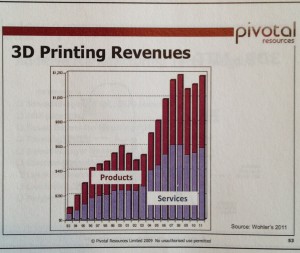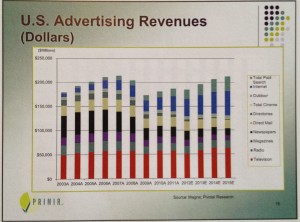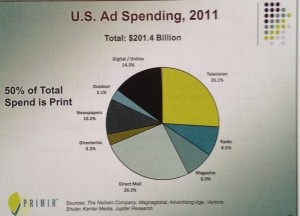
Last week, we traveled to New Orleans to attend the PRIMIR (Print Industries Market Information and Research Organization) meeting. PRIMIR funds and prepares extensive studies on trends in the graphics and print industry.
The three-day meeting provided presentations from previous studies, and break-out sessions to focus on future studies. The attendees were very diverse; coming from companies such as Xerox, Canon, Mimeo and Polytype America. Our varying backgrounds and experiences made for interesting conversations in the break-out groups as well as the networking events during the meeting.
A brief overview
The presentations were full of insights on the future of print, media and marketing from industry experts. The findings were backed up by research so following the trends and predicting the coming years seemed easy. We weren’t able to attend every session, but here’s a brief overview of some that we were able to attend.
Emerging Applications for Printing Technology, presented by Tom Ashley of Pivotal Resources USA
This was a technical presentation focusing on printed electronics and displays as well as security printing. One of the most significant aspects of this study was the market growth for 3D printing. Ashley was quoted as saying that it would eventually “change the world.”
Defining and Understanding Communications Platform Trends, presented by John Zarwin of J. Zarwan Partners
This study was sponsored by NPES, the umbrella organization that PRIMIR is part of, and sought to discover the implications for the print value chain based on advertising and marketing trends. It was clear from the numbers that the marketing venues of 10 years ago (newspapers, magazines, radio and television) are not the major players they were a decade ago as far as advertising dollars go. Digital media (read: social media, search, banner ads, etc.) is not going to stop growing anytime soon. It will always be changing; but it will continue to grow. What hasn’t changed is marketers’ main goal: brand building. It doesn’t matter where it happens; but it needs to happen.
Impact of Integrated Marketing on the Printing Industry, presented by Lisa Cross and Norman McLeod of InfoTrends
It wasn’t a big surprise to find out that the top five growth markets for advertising were automotive, financial services, food and beverage, health care and retail. These are all markets that just about everyone uses consistently. What was a surprise was to hear that of the $201.4 billion spent on advertising in the U.S. in 2011, 50 percent was print. And they say print is dead.
The Mobile Media Revolution: Will Print Become a Luxury Item?, presented by Roman Hohol of AMEC
Despite the findings in the previous study, Hohol answered his own question quite clearly at the very beginning of his presentation: Yes. Print will become a luxury item. Much of his opinion was based on the decline of the newspaper industry. He showed a picture of a woman enjoying a cup of coffee and reading a newspaper over breakfast. The next slide was a picture of the same woman reading the news on her iPad. It’s difficult to deny this particular trend; although his stance caused some great discussion among the group. We are, after all, print lovers and we don’t like to hear that it might become partially obsolete.
eCommerce and Print Business Models, presented by Riley McNultry, Bryan Yeager and Stephanie Pieruccini of InfoTrends
Of course, we had great interest in this topic. Much of our sales are through eCommerce and our clients are in the print industry. We were happy to hear that print eCommerce is growing and listened hard to this research group’s recommendations for software developers in this field. We’re not sure that we play “follow the leader” in our industry, but we definitely are open to partnering with customers or potential customers for further development. We do some of that already.
The overall takeaway
I asked our CEO Jim Raffel to give me a two-sentence overall takeaway from the PRIMIR Winter Meeting. What he said wraps it up beautifully:
Money is going to move to the new choices. TV, radio and print will remain viable; but the growth is search and social.



